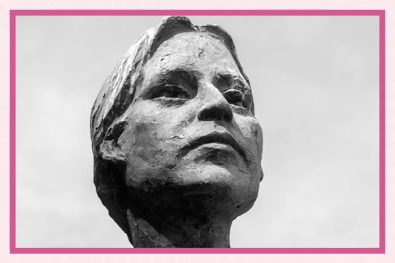In 1927, a beautiful young woman walked down a busy street in New York City. Dazed and distracted, she nearly wandered into oncoming traffic. At just the right moment, a stranger swept in and rescued her. When he got a chance to take a good look at the woman he just saved, he introduced himself as none other than media mogul Conde Nast, and insisted she come model for his magazines. Fast forward a few months and her face was on the cover of Vogue. Fast forward another decade, and she has transformed herself into a formidable war correspondent, the first female photojournalist to travel to the front lines of battle.
Here, we look back at the life and legacy twentieth-century female icon Lee Miller, from her early years as a model to her role in the Surrealist art movement of the twenties in Paris to the battlefields of World War II.
Early Years
Elizabeth (Lee) Miller was born in Poughkeepsie, New York, in 1907. In many respects, Lee had a comfortable and relatively privileged childhood, and she grew up to be a free-spirited, creative, and independent young woman.
However, there were several pivotal incidents in her younger years that no doubt impacted her psychologically and physically for years to come.
When she was seven years old, she suffered from a traumatic rape by a family friend that left her with gonorrhea, which required invasive and long-term treatment at the time. She lived with this secret until her death, and it was only uncovered by her son when he was researching her life to write her biography. In an interview with Vanity Fair, he says this experience likely gave her the “attitude that the world had failed her” and that “the only person who was really going to take care of her was herself.”
She gained valuable experience as a model from a young age by posing for her father, an amateur photographer. But some of these photographs appear inappropriate and disturbing and show her posing nude, and one wonders what their dynamic was like.
After a brief stint studying lighting and set design in Paris, she began modelling and studying art in Manhattan. In 1927, when she was 19 years old, she was discovered by magazine mogul Conde Nast. She started modelling for his publications and was on the cover of the March editions of both American and British Vogue.
Behind the Camera
A few years later, Lee left New York for Paris, where she encountered artists like Pablo Picasso, Joan Miro, and Max Ernst. Most importantly, she met Man Ray, a famous surrealist artist and photographer, and her life took a shift. She began to study under his tutelage and worked for him as his assistant, beginning her transition from model to photographer. She was determined to learn the craft herself, and become the one directing the shots, rather than appearing in them at someone else’s bidding.
She lived with him, and it was not long until their relationship of mentee and mentor transformed into one of muse and lover. Before long, they were full-fledged artistic collaborators and in 1929 they discovered the technique of solarization together, a stunning effect which reversed the negative and positive parts of a photo.
Together, the two of them produced a whole host of important works. During this period, she also acted in Surrealist filmmaker Jean Cocteau’s Le Sang d’un poete (1930 – 1932) and contributed to Paris Vogue as both a model and photographer.
By 1932, Lee and Man Ray had separated, and she decided to move back to New York. There, she opened her own studio with her younger brother, producing celebrity portraiture, surrealist photographs, and advertising work. Lee also revived her old relationship with American Vogue and started modelling and photographing for the magazine.
In 1934, she got married. She went to Cairo to live with her new husband, an Egyptian railroad magnate named Aziz Eloui Bey, where she took photos of the pyramids, ruins, and desert. During a solo trip to Paris in 1937 she met British Surrealist sculptor Roland Penrose and the two fell in love. They travelled around together, engaging in threesomes with other Surrealist artists, and by 1939, she left her husband to be with Penrose and moved to London.
Wartime Photographer
Soon, the war began. While she could have gone home to safety in America, she stayed. “I think she wanted to stay and try and do something,” her son told Vanity Fair. “And nobody was going to give her a gun or an airplane or something useful like that—so she used her camera.”
In London, Lee photographed the city during and after the Blitz, capturing the devastation left by the German night raids. She started contributing articles and photography to British Vogue and by 1943 she became their official accredited war correspondent. She joined forces with Life photographer David E. Scherman and they travelled to the front lines together, marking Lee as the first female photojournalist to do so. She arrived in Normandy in July 1944 and began to photograph and report on the Allied invasion of Nazi-occupied Europe and eventual liberation of the Dachau and Buchenwald concentration camps.
During her time as a war correspondent, she captured extraordinary scenes of historical significance, such as the Liberation of Paris, the field hospitals of Normandy, the atrocities of the concentration camps, and more. These images gave people an inside look at the gruesome reality of the war and served as some of the first pieces of photographic evidence of the Holocaust. In one legendary photo, she instructed Sherman to photograph her bathing in Hitler’s bathtub in his private apartment just after his suicide.
Later Years and Legacy
In 1947, she married Penrose, and they had a son, named Antony. She was 40 years old. A few years later, they bought a farm in East Sussex, where she hosted artists and intellectuals.
She continued to work as a photographer after the war, taking photographs of important figures in the art world, but after a few “botched assignments” in which she struggled to meet her deadlines, her career came to an anticlimactic end. Due to her experience on the frontlines, Lee struggled with PTSD (though this was not known at the time), depression, and alcoholism.
In the early 1950s, Lee studied at Cordon Bleu in Paris and reinvented herself into a Surrealist chef, hosting elaborately creative dinner parties, wowing her guests with surprising, absurd dishes like green chicken and blue fish.
She died of cancer in 1977 at the age of 70 years old, her career as an artist and photographer largely forgotten. Her death went mostly unnoticed with hardly any publications noted her death with an obituary.
Posthumously, her son discovered thousands of negatives, prints, documents, and writings of hers locked up in the attic, and he went on to archive and promote her work. This revived interest in Lee, and since then, there have been several exhibitions put on featuring her work, biographies written about her, a historical novel that tells the story of her tumultuous relationship with Man Ray, and a new biopic starring Kate Winslet, all proving that this fascinating icon of the twentieth century should not be forgotten in history.











